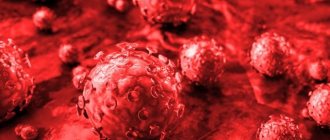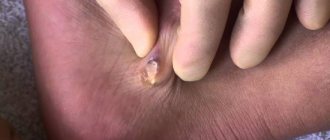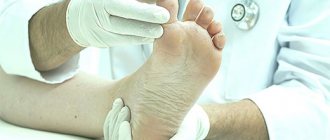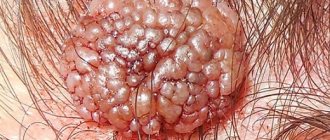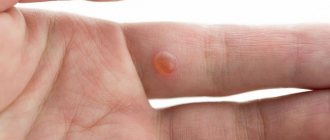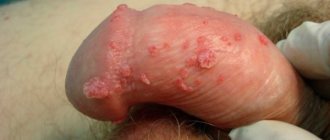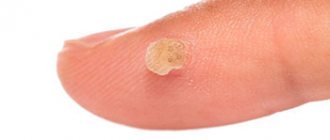Warts are benign growths caused by infection with the human papillomavirus. Their favorite location is the hands, as they are subject to the greatest contact with the environment and other people.
The virus penetrates the skin through microtraumas and scratches. The appearance of formations is directly related to the level of immunity of the infected person. The pathogen can remain in an inert state for a long time without appearing on the surface of the skin. Its DNA, when exposed to the human genome, causes abnormal cell proliferation. As a result, blood circulation at the injection site also increases, which leads to rapid growth of the affected units.
Most often, two types of warts appear on the hands:
- Simple or vulgar. The most common type, their appearance is observed in 70% of cases. The size varies from 0.3 to 1 cm. The color can be from pinkish to light brown. The main difference in the progression of the disease is the formation of a maternal wart surrounded by many small ones. When the main formation is removed, the rest disappear on their own.
- Flat or youthful. They occur mainly in young people 10-30 years old. They have a flat, smooth surface, do not exceed 0.5 cm. In most cases, they do not differ from the color of the skin, but may have a yellowish tint.
If neoplasms appear on your hands, the reasons most likely lie in the following:
- skin-to-skin contact with a sick person;
- use of personal belongings of an infected person;
- visiting swimming pools, baths and saunas, as the virus is well transmitted in warm and humid air;
- public items (handrails, door handles, vehicles, etc.);
- in beauty salons (when performing a manicure with non-disinfected instruments).
Please note that the disease may not develop for a long time. Activation of the pathogen occurs during stressful situations, poor ecology, long-term chronic diseases, vitamin deficiency and poor personal hygiene.
Types of warts
There are different types of warts depending on their location on the body, color, size, shape and type of pathogen.
Common or vulgar warts
The most common, their appearance does not depend on the age or gender of the patient. They are located on the hands, between the fingers, on the back of the palms (less often on the palms themselves). Vulgar warts have an irregular or round shape and, due to their flesh-pinkish color, are usually not very noticeable on the skin. The size varies from 1 to 3 mm; with prolonged infection and lack of treatment, groups of neoplasms may appear on the affected area.
Flat warts
Neoplasms of this type more often appear in children and adolescents, which is why their second name is juvenile warts. They are flesh-colored or light brown nodules of oval or round shape, with a smooth surface, slightly rising above the skin. They are predominantly localized on the skin of the face, neck, arms and upper torso.
Plantar warts
This type of wart appears exclusively on the skin of the feet, which is how it got its name. It is a rough growth with a keratinized layer of skin or a group of such growths. The skin around plantar warts loses its natural color and becomes gray-yellow. The surface of the wart becomes hard and begins to put pressure on the healthy tissue around it, causing severe discomfort.
Hanging warts
A feature of this species is the presence of a narrow articulation with the surface of the skin, the so-called “leg”. Hanging warts can be oblong, round or irregular in shape and pink or reddish in color. Such warts are localized on the neck, face, armpits, and under the breasts in women. Often, the appearance of numerous hanging warts signals a sharp decrease in the body’s immune status.
Senile warts
This type of wart most often affects the skin of older people. They are also called seborrheic warts or keratomas. They develop due to age-related changes and deterioration of metabolism from epidermal cells, often affecting the upper part of the hair follicles. Keratomas have a round shape, clearly defined boundaries, and are localized on the scalp or face. The size varies from a few millimeters to 4-5 cm.
Genital warts
Genital warts or condylomas are the most unpleasant and painful type of neoplasm. Their causative agent is human papillomavirus types 6 and 11. Genital warts affect the skin bordering the mucous membranes: on the lips and eyelids; in the genital area, urethra, anus.
Genital warts have a nodular growth pattern that is often compared to a cauliflower or cockscomb. Condylomas are connected to the surface of the skin through a thin “leg”. Due to their localization in areas of the body that are subject to mechanical irritation, there is a high degree of injury to condylomas and adjacent tissues, infection and the development of an inflammatory process with the formation of exudative or purulent discharge.
Causes of warts
The appearance of warts is caused by increased activity of the human papillomavirus in the body. Infection occurs through contact and household contact: through touch, handshakes, common objects and in public places if personal hygiene rules are not followed. Genital warts are transmitted sexually.
The virus becomes active in the presence of factors such as:
- severe or chronic stress;
- past infectious diseases;
- reduced immunity;
- hormonal imbalances, improper metabolism;
- increased sweating;
- trauma and microtrauma of the skin;
- wearing clothes and shoes made of non-natural materials.
If the disease is asymptomatic, it can only be diagnosed through laboratory testing.
How does infection occur?
Infection occurs through close contact with a carrier of the virus - through a handshake, kisses, when using common household items, personal belongings of the patient (towel, shoes, clothes). You can become infected in places with large crowds of people - in public transport, in a sauna, in a swimming pool. The papillomavirus thrives in a warm and humid environment, where it multiplies vigorously and is perfectly preserved on the surface of walls, floors, and benches. It is enough to walk on the floor barefoot or use someone else's shoes to get an insidious virus.
You can catch the infection by holding a door, pressing an elevator button, or grabbing the handrail of a vehicle. HPV quickly penetrates the cells of the epidermis if there is damage to the skin. It often enters the body during a manicure or pedicure if the instruments have not been thoroughly processed (disinfected).
The virus enters the body through tiny lesions on the skin, to which a person does not attach much importance. For example, through minor cuts after shaving, microtraumas (abrasions, scratches), abrasions on the feet and soles from tight or uncomfortable shoes. Dermatologists strongly recommend immediately treating any damage with an antiseptic - Chlorhexidine, hydrogen peroxide, Miramistin. This will help avoid many troubles.
Another route of infection is sexual contact with a carrier of the virus. Promiscuous relationships, neglect of protective equipment and hygiene are the shortest path to the appearance of genital warts or more dangerous and severe infections.
There is also a vertical route of infection, when a pregnant woman is a carrier of an active form of HPV, which provokes the formation of genital warts. In this case, the baby becomes infected at birth, during the process of passing through the birth canal.
If suspicious growths, growths, spots appear on the skin, you should not self-medicate and try to remove warts yourself. The first thing you need to do is consult a dermatologist, who will determine the nature of such formations and select the correct and adequate treatment.
Warts can be confused with other manifestations of dermatological pathologies, which can pose a danger due to the risk of degeneration into a malignant tumor. Therefore, any newly appearing formations on the skin should alert you and become a reason to visit a specialist and undergo a diagnostic examination.
Warts in adults
The appearance of papillomas or warts is possible at any age. Gender does not play a special role - both men and women are susceptible to HPV. At the same time, the risk of developing warts in women is higher, since their immunity is often weakened due to hormonal levels, pregnancy, and breastfeeding. Due to their anatomical structure, women are also more susceptible to the appearance of warts on the genitals, in particular condylomas, which increase the risk of developing cervical cancer.
In men, warts appear only in cases of a sharp decrease in immunity, which does not happen so often with the stronger sex. At the same time, men extremely rarely act as carriers of HPV types 16 and 18, which provoke the development of cancer.
Warts in children
Warts are a common occurrence in children and adolescents, since their immunity is not fully developed, as a result of which they are easily infected with papillomaviruses. An important role is played by the fact that children attending kindergartens and schools, as a rule, are in increased stressful conditions, which negatively affects the body’s protective abilities. In addition to the contact and household method of infection. Intrauterine infection from the mother is also possible.
Most often, children develop vulgar, juvenile or plantar warts, while juvenile warts disappear on their own by the age of 14-18.
Stories from our readers
Got rid of these terrible tumors at home. A month has already passed since I forgot about the bleeding and nasty growths in the most “prominent” places. Oh, I tried so many things - it helped, but only temporarily. How many times did I go to the clinic, but they prescribed useless medications over and over again, and when I returned, the doctors simply shrugged their shoulders. There were also folk remedies such as potatoes, which did not help. I also tried various celandines, which also turned out to be ineffective. I was already on the verge of a nervous breakdown and wanted to literally “cut” them, but then a miracle happened... Finally, there is not a single growth on my body and all thanks to this article. Anyone who has “unloved” growths should read this! You will forget about this problem forever, just as I forgot about it!
Read the full article >>>
For more information about warts in children, watch our video:
Treatment of warts
When treating warts, it should be understood that it is impossible to completely eliminate the pathogen - human papillomavirus - from the body. Once in the body, it remains in it forever, but a healthy immune system is able to keep it under control and minimize the manifestations of its vital activity.
The very fact of the appearance of warts indicates a decrease in the immune status of the body, therefore, it is necessary to include measures to strengthen the immune system in HPV therapy. With a reduced protective reaction of the body, even with successful removal of warts, there is a high probability of relapses. However, in people with strong immunity, warts can go away on their own.
Therapy should be selected by a competent doctor after a thorough examination. Self-medication is unacceptable, since a non-specialist will not be able to distinguish a wart from a malignant neoplasm. wart removal is also decided by a specialist - an injured neoplasm can degenerate from benign to malignant.
There are the following ways to get rid of warts.
- Cryodestruction (freezing with liquid nitrogen). This method is especially effective against common warts. The neoplasm is exposed to liquid nitrogen for 10-30 seconds. This method is good for its low risk of injury; complete removal of the wart requires from 1 to 5 sessions.
- Laser coagulation (laser removal). The tumor is removed in parts under local anesthesia. A mark in the form of a depression remains at the site of the wart, which disappears after about a month.
- Electrocoagulation (removal by electric current). The wart is removed with a thin metal loop using high-frequency current. This method is characterized by the absence of bleeding and additional tissue disinfection. The neoplasm tissue remains undamaged and can therefore be sent for histological examination. Traces of manipulation disappear within a week.
- Surgical excision. This method is used only in extreme cases, when the tumors are too large or are grouped into a single conglomeration. Under local anesthesia, the wart is removed with a scalpel, as in conventional surgery. The removed material is sent for histological examination. The presence of scars at the excision site depends on the skill of the surgeon who applied the sutures.
- A chemical treatment method that uses various acids or alkalis. This method is the most painful, traumatic and dangerous, since the risk of secondary infection of tissue at the site of exposure is extremely high. When deciding to use it, it is worth remembering that you can only act on the wart itself, without affecting the skin near it.
Diagnostic methods
An experienced doctor can make a preliminary diagnosis based on the appearance of the wart. The visual examination is supplemented by dermatoscopy - the study of the tumor using a special magnifying device. Under high magnification, the structure of the growth and characteristic features are clearly visible, allowing it to be differentiated from other formations (pigmented nevi, papillomas, seborrheic keratoma). A PCR blood test will help confirm the viral nature of the tumors.
If malignant degeneration is suspected, consultation with an oncologist is necessary. The patient is referred for an ultrasound and siascopy procedure, during which the formation is scanned with a special spectrophotometric apparatus. After making a diagnosis, the doctor selects a treatment regimen or decides how to get rid of a wart on a finger, hand, or other area of the upper limbs in a more radical way.
Preparations for the treatment of warts
Local remedies are used to treat warts, but their effectiveness depends on the age of the tumor - the “fresh” the wart, the greater the chance of removing it, and the state of the patient’s immunity.
- Viferon ointment. An antiviral agent that increases local immunity. Can be used for no more than a month, 1 to 4 times a day.
- Oxolinic ointment. This drug also has an antiviral effect. Apply to the wart 1-3 times a day. The treatment period ranges from a week to several months.
- Imiquimod cream. Immunomodulator with antiviral effect. Apply at night 2-3 times a week. Treatment period is up to 3 months.
- Salicylic acid. A concentrated solution must be used. Used as a lotion once a day. In this case, it is necessary to take measures against the occurrence of chemical burns to the skin.
- Kolomak. The drug is in the form of a solution based on salicylic, lactic acids and polidocanol. Apply 1-2 times a day, but not more than 10 mg per day. The course of treatment is no more than a month.
- Verrucacid. The solution is effective against many types of warts. In addition to the antiviral effect, it coagulates the intracellular protein of growths, preventing the development of relapses. It is applied once; in the presence of large tumors, re-application is possible after 1-2 weeks.
Before using local remedies, you should consult a dermatologist and undergo tests to determine the nature of the tumors, since exposure to medications can cause wart cells to degenerate into malignant ones.
Prevention
The most effective way to protect against warts is HPV vaccination. But it is advisable to do it in childhood. If the virus has already entered the body, it will not be possible to get rid of it once and for all. The infected person can only fight the emerging growths or try to prevent their appearance.
An infected person should regularly improve their immunity. This is facilitated by:
- sufficient exposure to fresh air;
- moderate physical activity;
- proper nutrition;
- taking vitamin and mineral complexes;
- rejection of bad habits;
- avoid hypothermia;
- correct daily routine.
If symptoms of any disease appear, you should not leave things to chance - you should consult a doctor and start treatment on time. This also applies to the warts themselves. If they appear once, you need to find out how to treat the tumors.

